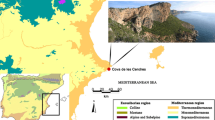Abstract
Całowanie site, which supported hunter-gatherer populations from ca. 11 380±95 until 8270±100 B.P., is the major terminal Palaeolithic and early Mesolithic occupation complex of the North European Plain. The archaeological layers are intercalated with biogenic sediments. The remains of plants that probably served as food were recovered from terminal Palaeolithic and early Mesolithic layers. Most of the charred plant remains, apart from wood charcoal, derives from vegetative parenchyma which forms a major part of organs such as root and tuber. Two taxa have been identified on the basis of the anatomy of parenchymatous tissue, namely Sagittaria cf. sagittifolia and Polygonum sp. In addition, several charred seeds and fruits were recovered. This is the first evidence for the probable use of plant foods, other than hazel nuts or water-chestnuts, in the diet of hunter-gatherers in the North European Plain during the Palaeolithic and Mesolithic.
Similar content being viewed by others
References
Arnason T, Hebda RJ, Jons T (1981) Use of plants for food and medicine by native peoples of eastern Canada. Can J Bot 59: 2189–2325
Coxworth ECM, Bell JM, Ashford R (1969) Preliminary evolution of Russian thistle, kochia and garden atriplex as potential high protein content seed crops for semiarid areas. Can J Plant Sci 49: 427–434
Dabrowski MJ (1981) Analiza pyłkowa torfowiska Całowanie (woj. warszawskie) [Pollen spectra of a peat profile from Całowanie (near Warsaw)]. Archeol Polski 26 (2): 269–294
Eidlitz K (1969) Food and emergency food in the circumpolar area. Stud Ethnograf Uppsaliensis 32: 1–175
Fahn A (1990) Plant anatomy, 4th edn. Pergamon Press, Oxford
Hather JG (1991) The identification of charred archaeological remains of vegetative parenchymous tissue. J Archaeol Sci 18: 661–675
Hather JG (1993) An archaeobotanical guide to root and tuber identification. 1: Europe and South Asia. Oxbow Monograph 28. Oxbow Books, Oxford
Hather JG (1994) A morphological classification of roots and tubers and its bearing on the origins of agriculture in southwest Asia and Europe. J Archaeol Sci 21: 719–724
Hather JG (1995) Parenchymatous tissues from the Early Neolithic site E-75–6 at Nabta Playa, Western Desert, South Egypt (preliminary report). Acta Palaeobot. 35: 157–162
Hillman GC (1989) Late Palaeolithic plant foods from Wadi Kubbaniya in Upper Egypt: dietary diversity, infant weaning, and seasonality in a riverine environment. In: Harris DR, Hillman GC (eds) Foraging and farming. One World Archaeology, Oxford, pp 207–233
Kuhnlein HV, Turner NJ (1991) Traditional plant foods of Canadian indigenous peoples: nutrition, botany, and use. Katz SH (Ser ed) Food and nutrition in history and anthropology. Volume 8. Gordon and Breach Science, Philadelphia
Mason SL, Hather JG, Hillman GC (1994) Preliminary investigation of the plant macro-remains from Dolni Vestonice II and its implications for the role of plant foods in the Palaeolithic and Mesolithic of Europe. Antiquity 68: 48–57
Maurizio A (1926) Pożywienie roślinne I rolnictwo w rozwoju dziejowym [Die Geschichte unserer Pflanzennährung]. Kasa Mianowskiego, Warszawa
Price TD (1987) The Mesolithic of western Europe. J World Prehist 1: 225–305
Schild R (1979) Chronostratigraphie et environnement du Paleolithigue final en Pologne. In: Sonneville-Brodes D (ed) La fin des temps glaciaires en Europe. Colloques internationaux, CNRS no. 271: 799–819
Schild R (1989) The formation of homogeneous occupation units (‘Kshemenitsas’) in open air sandy sites and its significance for the interpretation of Mesolithic flint assemblages. In: Bonsall C (ed) The Mesolithic in Europe. Donald, Edinburgh, pp 89–98
Schofield JJ (1989) Discovering wild plants. Alaska, western Canada, the Northwest. Alaska Northwest Books, Anchorage
Suttles WP (1955) Economic life of the coast Salish of Haro and Rosario straits. Ph.D. Dissertation. University of Washington, Seattle
Turner NJ (1981) A gift for the taking: the untapped potential of some food plants of North American native peoples. Can J Bot 59: 2331–2357
Turner NJ, Kuhnlein HV (1982) Two important “root” foods of the northwest coast Indians: springbank clover (Trifolium wormskioldii) and Pacific Silverweed (Potentilla Anserina ssp. pacifica). Econ Bot 36: 411–432
Zvelebil M (1986) Hunters in transition: Mesolithic societies of temperate Eurasia and their transition to farming. Cambridge University Press, Cambridge
Zvelebil M (1994) Plant use in the Mesolithic and its role in the transition to farming. Proc Prehist Soc 60: 35–74
Author information
Authors and Affiliations
Rights and permissions
About this article
Cite this article
Kubiak-Martens, L. Evidence for possible use of plant foods in Palaeolithic and Mesolithic diet from the site of Całowanie in the central part of the Polish Plain. Veget Hist Archaebot 5, 33–38 (1996). https://doi.org/10.1007/BF00189433
Received:
Accepted:
Issue Date:
DOI: https://doi.org/10.1007/BF00189433




